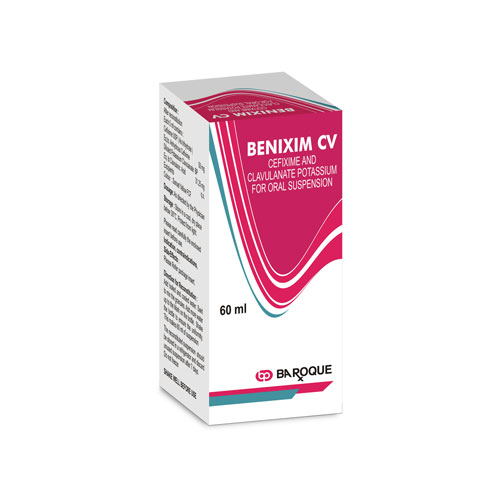
BENIXIM CV Oral Suspension
Therapeutic Class
Cephalosporins
Indications
Cefixime-Clav should be used only to treat or prevent infections that are proven or strongly suspected to be caused by susceptible bacteria. Cefixime-Clav is indicated for the treatment of: Uncomplicated Urinary Tract Infections caused by Escherichia coli and Proteus mirabilis. Otitis Media caused by Haemophilus influenzae (beta-lactamase positive and negative strains), Moraxella (Branhamella) catarrhalis, (most of which are beta- lactamase positive) and S. pyogenes* -Pharyngitis and Tonsillitis, caused by S. pyogenes. Acute Bronchitis and Acute Exacerbations of Chronic Bronchitis, caused by Streptococcus pneumoniae and Haemophilus influenzae (beta-lactamase positive and negative strains). -Uncomplicated gonorrhea (cervical/urethral), caused by Neisseria gonorrhoeae (penicillinase-and non-penicillinase- producing strains).
Chemical Composition
After reconstitution each 5 ml contains Cefixime USP (As trihydrate) eq. to Anhydrous Cefixime 50 mg,
Diluted Potassium Clavulanate BP eq. to Clavulanic acid 31.25 mg
Excipients
Color: Sunset yellow FCF
Packaging
60 ml / Bot
Dosage & Administration
Paediatric: It is used to treat bacterial infections such as urinary tract infections, chest and throat infections, ear infections which are otherwise difficult to treat with cefixime alone. The dose in children 6 months & above is 8 mg/kg/day. This dose may be given as a single daily dose or 4 mg/kg may be given every 12 hours.
Contraindications
Cefixime and Potassium Clavulanate tablet/ suspension are contraindicated in patients with known hypersensitivity to cephalosporin antibiotics.
Warning & Precautions
Cefixime and Potassium Clavulanate tablet/ suspension should be given with caution to patients who have shown hypersensitivity to penicillin-sensitive patients, as there is some evidence of partial cross allergenicity between the penicillins and cephalosporins . If an allergic effect occurs with, the drug should be discontinued and the patient treated with appropriate agents if necessary. Treatment with broad spectrum antibiotics alters the normal flora of the colon and may permit overgrowth of clostridia and may result in antibiotic-associated diarrhoea . Pseudomembranous colitis is associated with the use of broad-spectrum antibiotics; it is therefore important to consider its diagnosis in patients who develop diarrhoea in association with the use of antibiotics.
Side Effects
The majority of adverse reactions are mild and self-limiting in nature. The most frequent side effects seen with Cefixime are diarrhoea, stool changes, nausea, abdominal pain, dyspepsia, vomiting and flatulence, headache, dizziness, allergies in the form of rash, pruritus, drug fever, arthralgia, including rare cases of urticaria or angioedema, erythema ·multiforme, Stevens-Johnson syndrome, thrombocytosis, thrombocytopenia, leucopenia, hypereosinophilia,neutropenia, agranulocytosis, transient rises in liver transaminases, alkaline phosphatase and jaundice can also occur.
Drug Interaction
Carbamazepine: Elevated carbamazepine levels have been reported when cefixime is administered concomitantly. Warfarin and Anticoagulants: Increased prothrombin time, with or without clinical bleeding, has been reported when cefixime is administered concomitantly. Oral Contraceptives: Cefixime may interfere with the effectiveness of birth control pills. Glucose Test: A false positive reaction for glucose in the urine may occur with Benedict's or Fehling's solutions or with copper sulphate test tablets. Coombs test: A false positive direct Coombs test has been reported during treatment with cephalosporin antibiotics.

